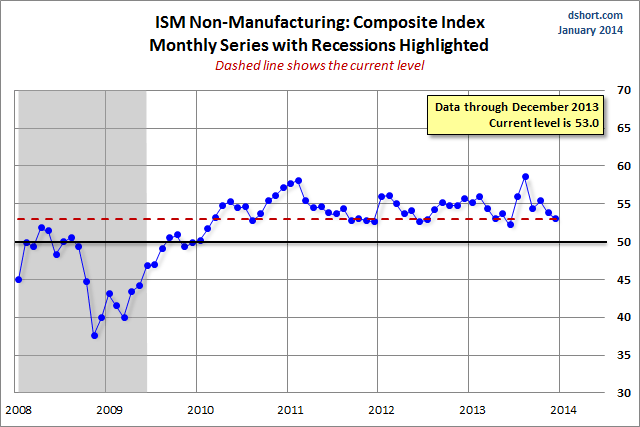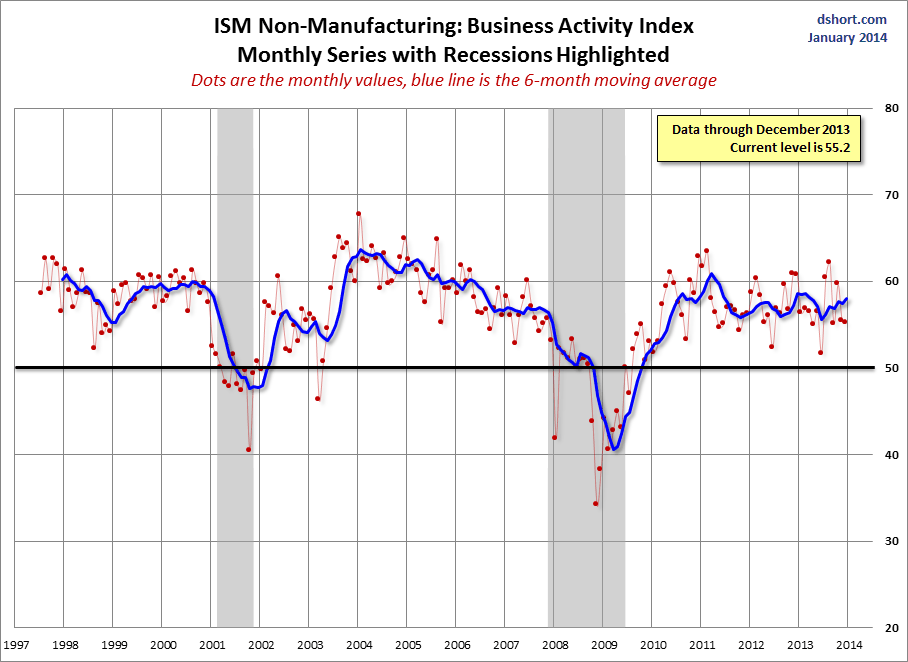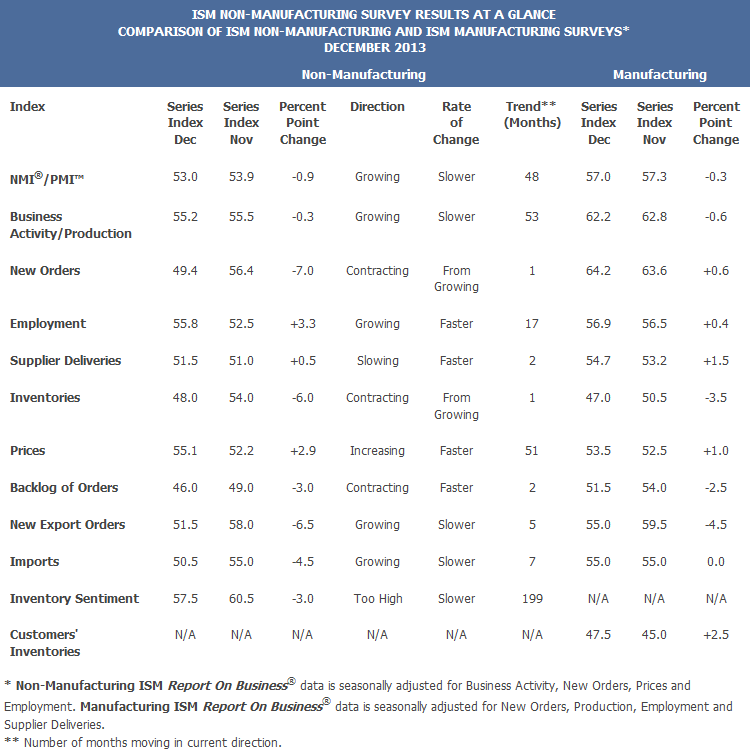Today the Institute for Supply Management published its latest Non-Manufacturing Report. The headline NMI Composite Index is at 53.0 percent, signaling slower growth than last month's 53.9 percent. This is the second consecutive month of slower growth. Today's number came in below the Investing.com forecast of 54.5, which was close to the 54.6 consensus posted by Briefing.com.
Here is the report summary: The NMI® registered 53 percent in December, 0.9 percentage point lower than November's reading of 53.9 percent. This indicates continued growth at a slightly slower rate in the non-manufacturing sector. The Non-Manufacturing Business Activity Index decreased to 55.2 percent, which is 0.3 percentage point lower than the 55.5 percent reported in November, reflecting growth for the 53rd consecutive month, but at a slightly slower rate. The New Orders Index contracted after 52 consecutive months of growth for the first time since July 2009, when it registered 48 percent. The index decreased significantly by 7 percentage points to 49.4 percent, and the Employment Index increased 3.3 percentage points to 55.8 percent, indicating growth in employment for the 17th consecutive month and at a faster rate. The Prices Index increased 2.9 percentage points to 55.1 percent, indicating prices increased at a faster rate in December when compared to November. According to the NMI®, eight non-manufacturing industries reported growth in December. Despite the substantial decrease in the New Orders Index, respondents' comments predominately reflect that business conditions are stable.
Like its much older kin, the ISM Manufacturing Series, I have been reluctant to focus on this collection of diffusion indexes. For one thing, there is relatively little history for ISM's Non-Manufacturing data, especially for the headline Composite Index, which dates from 2008. The chart below shows Non-Manufacturing Composite. We have only a single recession to gauge is behavior as a business cycle indicator.
In my view, the more interesting and useful subcomponent is the Non-Manufacturing Business Activity Index. The latest data point at 55.2 percent is a -0.3 decline from the previous month.
For a diffusion index, this can be an extremely volatile indicator. Thus I've added a six-month moving average to assist us in visualizing the trend, which has been relatively range bound for the past two years.
Theoretically, I believe, this indicator will become more useful as the timeframe of its coverage expands.
Manufacturing may be a more sensitive barometer than Non-Manufacturing activity, but we are increasingly a services-oriented economy, which explains my intention to keep this series on the radar.
Here is a table showing trend in the underlying components.
Here is a link to my coverage of ISM Manufacturing report released earlier this week.
Note: I use the FRED USRECP series (Peak through the Period preceding the Trough) to highlight the recessions in the charts above. For example, the NBER dates the last cycle peak as December 2007, the trough as June 2009 and the duration as 18 months. The USRECP series thus flags December 2007 as the start of the recession and May 2009 as the last month of the recession, giving us the 18-month duration. The dot for the last recession in the charts above are thus for November 2007. The "Peak through the Period preceding the Trough" series is the one FRED uses in its monthly charts, as illustrated here.
- English (UK)
- English (India)
- English (Canada)
- English (Australia)
- English (South Africa)
- English (Philippines)
- English (Nigeria)
- Deutsch
- Español (España)
- Español (México)
- Français
- Italiano
- Nederlands
- Português (Portugal)
- Polski
- Português (Brasil)
- Русский
- Türkçe
- العربية
- Ελληνικά
- Svenska
- Suomi
- עברית
- 日本語
- 한국어
- 简体中文
- 繁體中文
- Bahasa Indonesia
- Bahasa Melayu
- ไทย
- Tiếng Việt
- हिंदी
ISM Non-Manufacturing: Second Month Of Slower Growth Than Expected
Published 01/07/2014, 12:47 AM
Updated 07/09/2023, 06:31 AM
ISM Non-Manufacturing: Second Month Of Slower Growth Than Expected
Latest comments
Install Our App
Risk Disclosure: Trading in financial instruments and/or cryptocurrencies involves high risks including the risk of losing some, or all, of your investment amount, and may not be suitable for all investors. Prices of cryptocurrencies are extremely volatile and may be affected by external factors such as financial, regulatory or political events. Trading on margin increases the financial risks.
Before deciding to trade in financial instrument or cryptocurrencies you should be fully informed of the risks and costs associated with trading the financial markets, carefully consider your investment objectives, level of experience, and risk appetite, and seek professional advice where needed.
Fusion Media would like to remind you that the data contained in this website is not necessarily real-time nor accurate. The data and prices on the website are not necessarily provided by any market or exchange, but may be provided by market makers, and so prices may not be accurate and may differ from the actual price at any given market, meaning prices are indicative and not appropriate for trading purposes. Fusion Media and any provider of the data contained in this website will not accept liability for any loss or damage as a result of your trading, or your reliance on the information contained within this website.
It is prohibited to use, store, reproduce, display, modify, transmit or distribute the data contained in this website without the explicit prior written permission of Fusion Media and/or the data provider. All intellectual property rights are reserved by the providers and/or the exchange providing the data contained in this website.
Fusion Media may be compensated by the advertisers that appear on the website, based on your interaction with the advertisements or advertisers.
Before deciding to trade in financial instrument or cryptocurrencies you should be fully informed of the risks and costs associated with trading the financial markets, carefully consider your investment objectives, level of experience, and risk appetite, and seek professional advice where needed.
Fusion Media would like to remind you that the data contained in this website is not necessarily real-time nor accurate. The data and prices on the website are not necessarily provided by any market or exchange, but may be provided by market makers, and so prices may not be accurate and may differ from the actual price at any given market, meaning prices are indicative and not appropriate for trading purposes. Fusion Media and any provider of the data contained in this website will not accept liability for any loss or damage as a result of your trading, or your reliance on the information contained within this website.
It is prohibited to use, store, reproduce, display, modify, transmit or distribute the data contained in this website without the explicit prior written permission of Fusion Media and/or the data provider. All intellectual property rights are reserved by the providers and/or the exchange providing the data contained in this website.
Fusion Media may be compensated by the advertisers that appear on the website, based on your interaction with the advertisements or advertisers.
© 2007-2024 - Fusion Media Limited. All Rights Reserved.
